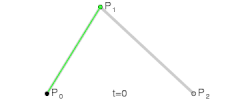Bézier curve
Jump to navigation
Jump to search
English
[edit]

Etymology
[edit]Probably a calque of French courbe de Bézier. Named after Renault engineer Pierre Bézier who popularized the curves developed earlier by Paul de Casteljau and used them to design curves for the bodywork of cars.
Pronunciation
[edit]Noun
[edit]Bézier curve (plural Bézier curves)
- (mathematics, computer graphics) A type of parametric curve defined by a set of control points, two of which are the ends of the curve, while the others determine its shape. [From 1960s.]
- Synonym: bezier
- Bézier curves are applied, for example in computer graphics and animation, to produce smooth, infinitely scalable curves.
- 2003, Samuel R. Buss, 3D Computer Graphics: A Mathematical Introduction with OpenGL, Cambridge University Press, page 163:
- So, instead, it is often better to combine multiple Bézier curves to form a longer, more complicated curve called a piecewise Bézier curve.
This section discusses how to join Bézier curves together – especially how to join them so as to preserve continuity and smoothness (i.e., continuity of the first derivative).
- 2008, T. Theoharis, G. Papaioannou, N. Platis, N. M. Patrikalakis, Graphics & Visualization: Principles and Algorithms[1], Taylor & Francis (A K Peters / CRC Press), page 193:
- The initial points p0, p1, and p2 are called control points of the Bézier curve. […] The process outlined above for the generation of a quadratic Bézier curve from its three control points can be generalized for more control points in a straightforward manner.
- 2012, Frank Klawonn, Introduction to Computer Graphics: Using Java 2D and 3D, 2nd edition, Springer, page 151:
- When an affine transformation is applied to the control points, the resulting Bézier curve with respect to the new control points coincides with the transformed Bézier curve. Therefore, Bézier curves are invariant under affine transformations like rotation, translation or scaling. Bézier curves are also symmetric with respect to their control points.
Related terms
[edit]Translations
[edit]kind of parametric curve
|
See also
[edit]Further reading
[edit] Bernstein polynomial on Wikipedia.Wikipedia
Bernstein polynomial on Wikipedia.Wikipedia  De Casteljau's algorithm on Wikipedia.Wikipedia
De Casteljau's algorithm on Wikipedia.Wikipedia - Bézier curve on Encyclopedia of Mathematics
Categories:
- English terms calqued from French
- English terms derived from French
- English eponyms
- English 3-syllable words
- English terms with IPA pronunciation
- English lemmas
- English nouns
- English countable nouns
- English multiword terms
- English terms spelled with É
- English terms spelled with ◌́
- en:Mathematics
- en:Computer graphics
- English terms with usage examples
- English terms with quotations
